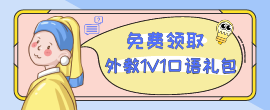-
【大家一起学发音】[əu]和[ai]该怎么发一起(视频)
Video Text: The [əu] sound does not [w]occur[/w] on its own. It is always in diphthong with the "uh" as in "pull" sound. For example, 'no.' It's not 'no,' 'no.' To make this sound the corners of the mouth come in a little, oh, which meant that the lips themselves press out a little bit: oh, oh. The tongue comes up a little bit in the back, and the tip of the tongue comes forward, oh, and is extremely lightly touching the soft part of the mouth [w]underneath[/w] the front teeth, right here. [əu]这个音容易与pull中的[u]音混淆,例如no一词要念作[nəu]而不是[nu]。发这个音时,嘴角略微向内收拢,也就是说嘴唇要向外突出。舌根稍稍向上抬起,舌尖朝前伸,轻轻触碰门牙下侧的柔软处。 Sample words: no 不 go 走 Sample sentence: Mr. Stone shows off his snowmobile. Stone先生向人炫耀他的雪地车。 Video Text: The [ai] diphthong. This combines the ah as in father and the ih as in sit. Aahh-iihh. In the ah vowel, the tongue is very relaxed, so the front is just kind of sitting there. Ah. However for the ih, it moves up a little on the back of the teeth. Aahh-iihh. So I would say the [w]emphasis[/w] goes from the back of the tongue to the front. [ai]这个音包
-
【大家一起学发音】[æ]该怎么发一起(视频)
成了一座“墙”。 [æ]与[e]不同之处在于:发[e]时舌尖触及下
-
大家一起学发音:[l]该怎么一起学发音:[l]该怎么发
Video Text: [en]The [l] sound. To make this sound, we use the very tip of the tongue, and we press that to the roof of the mouth. This is different from the nn, N sound in which we use the forward part of the top of the tongue to touch the mouth. In the L, ll, we're actually using the very tip, which means the tongue has to [w]curve[/w] up to touch. Ll, ll. Because the tongue is curving like that, that means this part of the tongue is actually touching the back part of the front teeth. But where the pressure happens is where the tip of the tongue reaches up to touch the roof of the mouth. Ll, ll, ll. The rest of the mouth stays relaxed.[/en][cn]发辅音[l]时,舌尖要顶在上颚。我们在发[n]音时,我们用舌的前端部分顶住上颚;但是,发[l]的时候,我们用的只是舌尖,也就是说要卷舌才
-
【大家一起学发音】[ɔ:]该怎么发一起(视频)
外张。ah,aw. 再有,发这两个音时舌头也是有细小变化的。在发father中的ah时,舌头是平放着的;虽然发law中的aw时,舌头也是平放着,但是区别在于后部。发aw时舌头要向后移一些,也就是向喉咙处移动。ah, aw. 就是这样造成了声音的细微差异。[/cn] Sample words: [en]law[/en][cn]法律[/cn] [en][w]crawl[/w][/en][cn]爬行[/cn] [en][w]log[/w][/en][cn]圆木[/cn] Sample sentence: [en]Your daughter is taller than when I saw her last fall.[/en][cn]您女儿比我去年秋天看到她时长高了。[/cn]
-
【大家一起学发音】[εə]该怎么发一起(视频)
个R音。有些研究材料认为其中的[ə]并不发音,它们认为发[εə]这个音时是直接从[e]到R音。但是还有很多资料的观点是不同的,它们认为:第一个音是[e],bed中的[e];第二个音是[ə],supply中的[ə];而第三个音则是R音。 用慢动作来念[εə]就是:eeeeehhhhhhh uuuuuuuuhhhhhhh rrrrrrrrr。舌头的位置从发[e]音时较高的地方变化到发[ə]音时较中间的地方。而R音和
-
【大家一起学发音】[ə]该怎么发一起(视频)
Video Text: [en][ə], the [w]schwa[/w] sound. A lot of languages have a schwa. How do we make it? It's like I wanted to make a noise without moving anything at all. Uh, uh. As you can see, the lips are [w]barely[/w] apart, the teeth are barely apart, the tongue is forward and relaxed, the [w]cheek[/w] and lips are completely relaxed. Uh.[/en] [cn][ə]是中元音(发音时,舌位、唇形、开口度始终不变的元音叫中元音),很多语言中都有中元音。我们该怎么发这个音呢?这就好像我要在没有任何动作的情况下要发出声音一样。Uh, uh. 正如你所看到的,嘴唇和牙齿就这么张开,舌头在前部松弛着,脸颊和嘴唇都彻底放轻松。Uh.[/cn] Sample words: [en][w]sublime[/w][/en] [cn]崇高的[/cn] [en]heaven[/en] [cn]天堂[/cn] Sample sentence: [en]Today and tomorrow I'll be in Tallahassee.[/en] [cn]今明两天我会在塔拉哈西。[/cn]
-
【大家一起学发音】[ɛ]该怎么发一起(视频)
Video Text: [en]The [ɛ] sound. It's a vowel, but it's a lot like the "r" [w]consonant[/w]. To make this vowel sound, the tongue fattens up and comes up a little bit in the back. Ur. So, the back of my tongue is touching the back of my throat. Ur, ur. Because it has fattened itself up in the back, so it can touch back there, what that means is that the front of the tongue is not touching anything. It's just, ur, hanging out in the middle of my mouth. As you can see, the lips, ur, they do a lot like they do on the vowel uh(pull) they come in a little bit and the lips go out a little bit. Ur: learn, brrr it's cold! (It's not really.) Ur. Brrr, learn, person.[/en][cn][ɛ]音是一个元音,不过它和辅音r的发音有很多相似处。发此音时,舌根处摊平并略微抬起。Ur. 舌跟碰到喉咙的后部。Ur, ur. 因为舌跟处放平了,所以它
-
【大家一起学发音】[iə]该怎么发一起(视频)
更像一个放松发出的[i:]而不是纯粹的sit中的[i]。第二个音便是[ə],它出现得非常之快,刚发出你就进入到后面的R音了。如果我们用慢动作来念就是这样:iiiiihhhhhh uuuuuhhhhhh rrrrrrr。 Sample words: [w]sheer[/w] 全然,十足 [w]steer[/w] 驾驶,掌舵 near 靠近 Sample sentence: I fear my career is near its end. 我感觉到自己的职业生涯就快结束了。 进入【大家一起学发音一起】系列>>
-
【大家一起学发音】[i]该怎么发一起(视频)
Video Text: The [i] sound is very close to [i:], but it's not quite as forward and the mouth is not quite as closed. Ih. And the part of my tongue that touches the roof of my mouth is acutally the back part of my tongue touching the back part of the roof of my mouth. Ih, ih. And as you can see, the jaw hangs just a little bit, and the lips come out just a little bit. If I didn't [w]widen[/w] them here it would look like this: ih. Ih, ih, ih. [i]的发音与[i:]很接近(>>戳我去看[i:]如何发音<<),但是它不像[i:]那么靠前,开头也没那么小。发这个音时,舌头与上颚的触及点是在舌根以及上颚的后部。另外,下巴只需略微上移,嘴唇稍稍突出,嘴角需要向两侧拉伸。 Sample words: [w]kit[/w] 工具箱 [w]fix[/w] 修理 Sample sentence: The women missed the little cat. 女人们都想念那只小猫。 点击进入【大家一起学发音一起】系列>>
-
【大家一起学发音】[au]该怎么发一起(视频)
紧些,嘴角有明显的上扬;而发[au]中的第一个音时是下颌要下垂一点,嘴角没有那么上扬。不过发两个音时,舌跟都要抬起然后向前舒展。[au]的第二个音写做pull中的[u],但是它更接近于boo中的[u:]音,但是唇形没有收得那么紧。 Sample words: cow 奶牛 bough 大树枝 sound 声音 Sample sentence: I came back from vacation and found my flowers dead and brown. 度假回来发现我养的花已经死了,都变成棕色的了。
搜索
查词
阅读排行榜
- 1
- 2
- 3
- 4
- 5
- 6
- 7
- 8
热搜榜
- 1 330018
- 2 135567
- 3 122053
- 4 59437
- 5 59378
- 6 58994
- 7 43524
- 8 40720


